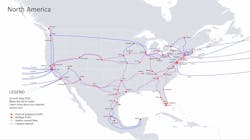Arelion finds network and operational efficiencies with IPoDWDM
Arelion continues to find ways to expand the capabilities of its optical network to enhance network efficiency and reduce costs over longer spans.
A key component of achieving its network goals is using IP over DWDM. IPoDWDM is a technology that combines IP routers and switches with an Optical Transport Network (OTN). It transmits data packets over optical networks.
The provider recently completed a live network field trial on its 2,253 kilometers route from Chicago to Denver using IPoDWDM via Cisco 400G Ultra Long Haul (ULH) QSFP-DD Coherent pluggable optical modules and Cisco 8000 series routers powered by Cisco Silicon One.
While the trial is new, Arelion has plenty of experience using 400G IPoDWDM, having deployed over 900 ports of the technology in its network. Most of its deployments of IPoDWDM were over shorter distances in its network.
Dariusz Solowiej, VP of Networks and Operations for Arelion, said this route was key because it proves the company can apply IP over DWDM technology over longer distances in its network.
The provider can also replace expensive optical transponders in the optical network by using the plugs in the routers directly.
“With the previous technology, you could not reach all of the backbone routers, which is why we had a mixture of IPoDWDM and traditional WDM for longer stretches,” he said. “We have chosen this stretch between Denver and Chicago because it’s the longest distance between the two backbone routers we have in the network.”
He added that the trial could give it confidence to implement across its network. “So, if we were able to reach that far, then it means that we could use IPoDWDM 400G throughout the whole network over time,” he said.
Enhancing spectral efficiency
Besides demonstrating the use of IPoDWDM at longer distances, another key aspect was enhancing spectral optical efficiency.
This trial demonstrated IP transmission at a spectrum of 112.5 gigahertz over 2,253 kilometers, with healthy margins. It claims it provides longer transmission distances and higher cost savings than currently deployed transponders.
One key element of Cisco’s 400G ULH QSFP-DD pluggable coherent optical modules is that they can optimize network architecture by consolidating excessive hardware with greater than +1 dBm transmit power. As a result, providers like Arelion can cut the number of interfaces to maintain and mitigate financial barriers to network expansion.
The shift to coherent pluggable optics was initially driven by hyperscaler data center operators, who pushed for shorter spans and point-to-point high-capacity links. The emergence of ZR optics was a key catalyst.
400G ZR optics define an economical and interoperable standard for transferring 400 Gigabit Ethernet over a single optical wavelength using DWDM (dense wavelength division multiplexing) and higher-order modulation such as 16 QAM.
The Optical Interoperability Forum (OIF) previously developed this low-cost data transmission standard as one of the first standards to define an interoperable 400G interface. The ZR+ represents a series of coherent pluggable solutions holding line capacities up to 400 Gbps and stretching well past the 120km specification for 400ZR.
“We wanted the trial to prove we can reach longer distances and ensure spectrum efficiency,” Solowiej said. “We achieved both spectral efficiency comparable to traditional transponders.”
Arelion is preparing the second use case for technology. While the previous trial used 112 gigahertz, the second trial we are working on will use 75 gigahertz over a shorter distance of 1,500 kilometers.
“We want to try this one because we will go down with end-of-life margins but to be able to gain more spectrum efficiency as a trial,” Solowiej said. “We don't see the current parameters of end-of-life as applicable because the optics are cheaper, so we don't need to look at this the same way we were looking at transponders.”
Reducing IP network costs
As it enhances spectral efficiency, Arelion will reduce CAPEX costs on its IP backbone network. Cisco's 400G ULH pluggable enables Arelion to reduce CAPEX by 35% and OPEX costs by 84% when expanding its network.
This provides a broader reach with high capacities that support customers' AI/ML and cloud applications.
The initial focus is on Arelion’s IP backbone. About 50% of the provider’s transmission network is used for IP purposes, while the other 50% is used to deliver services to its carrier and business customers.
“The aim here is to ensure that our IP network is very cost-efficient,” Solowiej said. “We are using this technology or the previous technology with IPoDWDM for 100G, but we see this as stable technology because we haven't had many issues.”
Because this technology has proven to save various capex and opex, Arelion plans to conduct other field trials and deployments this year.
“Because this technology office has capital and operational cost savings, we have very aggressive plans of deploying this technology,” Solowiej said. “All the new capacity going over the IP network is going to use this technology, and then, at the same time, we want to start migrating off transponders.”
New working procedures, processes
Given the benefits Arelion's experience in implementing IPoDWDM has for its network, it can also make its operational processes more efficient.
Team cooperation has become closer because everyone knows each other’s plans.
A typical challenge for large providers is that they typically have separate IP networks and transmission teams. Arelion had to operationally integrate these teams to support the implementation of the new technology.
Solowiej said this process is already going well. “We have passed this stage already, so we don’t see any operational organization difficulties in operating the network fully or to a great extent on IP over DWDM,” he said.
At Arelion, Solowiej and other team members from the operations group have received positive feedback. The IP and transmission groups are working very closely together.
“They understand each other when they talk about parameters,” Solowiej said. “Every organization worries about how they will operate it when suddenly you have distant knowledge between IP and transmission, but this allowed us to increase their cooperation.”
He added that we had to “change procedures and responsibilities, but the feedback I got from all the teams, including engineering, planning, and implementation, was that it is a very positive change because it helped them broaden their horizons.”
Routed optical networking
Following this field trial, Arelion said it will “substantially improve” its Routed Optical Networking reach through additional deployments of Cisco 400G ULH pluggables, enabling it to better support wholesale and enterprise customers' connectivity needs across North America.
This technology will allow Arelion to introduce Cisco’s Routed Optical Networking to long-haul networks in previously challenging geographies.
As part of Cisco’s Converged SDN Transport architecture, Routed Optical Networking simplifies the physical network infrastructure, just as EVPN and Segment Routing streamline the service and traffic engineering network layers.
It collapses complex technologies and network layers into a cost-efficient, easy-to-manage network infrastructure. In the U.S., Cisco’s technology has enabled Arelion to transmit across the most extended distances between its backbone routers.
“With previous technologies, we have addressed Europe and parts of the U.S., but this technology allowed us, or will allow us, to address our whole IP network,” Solowiej said.
However, Arelion's goal is operational efficiency. What was once two separate networks is now one. “The biggest issue that companies perceive is the operational part because what was two separate networks is now one,” Solowiej said. “Teams must know about transmission and IP.”
For related articles, visit the Optical Tech Topic Center.
For more information on optical components and suppliers, visit the Lightwave Buyer’s Guide.
To stay abreast of optical communications technology, subscribe to Lightwave’s Enabling Technologies Newsletter.
About the Author
Sean Buckley
Sean is responsible for establishing and executing the editorial strategy of Lightwave across its website, email newsletters, events, and other information products.




